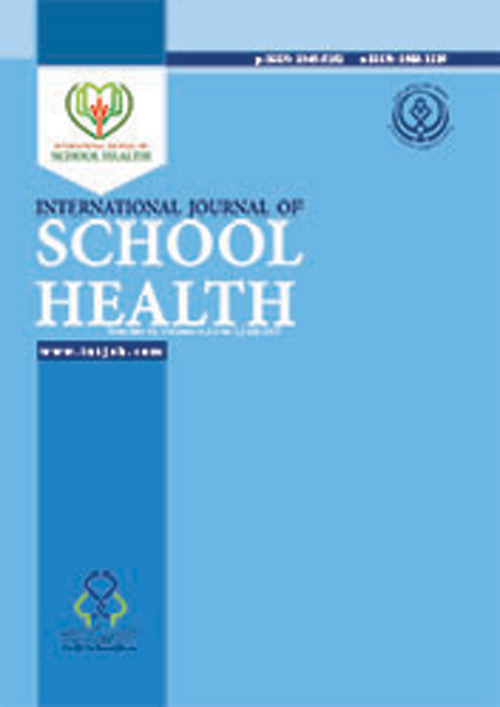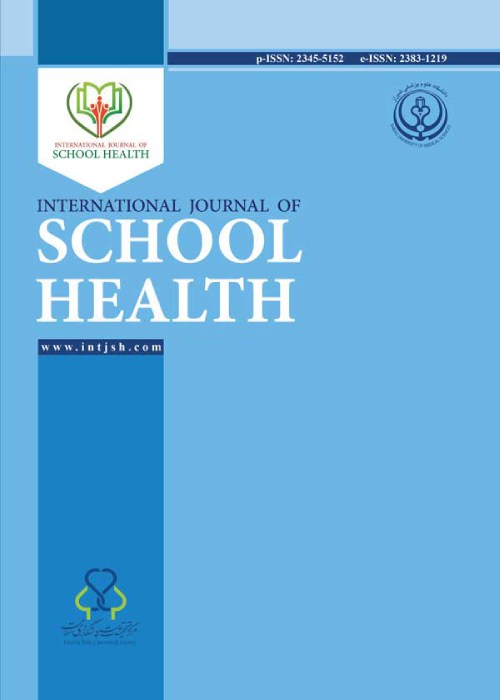فهرست مطالب

International Journal of School Health
Volume:5 Issue: 1, Winter 2018
- تاریخ انتشار: 1396/10/28
- تعداد عناوین: 6
-
-
Page 1BackgroundNowadays, suicidal attempts of adolescents, which are done with different methods, have caused a great concern in communities. Thus, this study aimed at surveying the reasons of suicidal attempts leading to hospitalization.MethodsThis was a case-control study conducted on 300 adolescents during 1 year. In this study, 150 adolescents younger than 18 years, who were hospitalized due to suicidal attempt and referred to Nemazi hospital, were selected. After the primary measures were done and the patients gained consciousness, they were asked to fill out a questionnaire on the factors affecting suicidal attempt. Another questionnaire containing similar questions was filled out by 150 age-matched adolescents, as the control group, who referred to Nemazi hospital for problems other than suicide.
The patients with chronic or advanced disease were excluded. Data were analyzed in SPSS, Version 17, using t test, chi-square, and logistic regression tests. In this study, the role of religion and beliefs in suicidal attempts was investigated.ResultsComparison of the 2 groups revealed a significant relationship between suicidal attempt and factors such as sex (P valueConclusionsAccording to the results, special attention should be paid to family grounds. In this respect, the role of parents and instructors is highly important. Moreover, the preventive role of religion, especially Islam, in preventing suicide is essential.Keywords: Suicide, Adolescent, Religious Belief -
Page 2BackgroundSelf-esteem, attributional styles, and self-handicapping play key roles in students individual and social performances. Through determining interactional relations among these factors, parents and schools can plan for improving students performances.ObjectivesHence, this study aimed to investigate the relationship of self-esteem and attributional styles with self-handicapping among primary school students.MethodsThe statistical population of this study comprised of 3rd to 5th grades of primary school students in Zahedan, during the 2015 - 2016 academic year. The research sample consisted of 365 primary students (154 boys and 211 girls) aged 9 to 11 years old who were selected using the random cluster sampling method. The research measurement tools were the Seligman et al. Childrens attributional style questionnaire, the rosenberg self-esteem scale, and the Midgley et al. self-handicapping scale. The statistical analyses were performed via SPSS16 using both descriptive and inferential statistics including the correlation test and the Inter regression analysis.ResultsThe descriptive results indicated that the means of the pessimistic (9.15), optimistic (9.39) attribution styles, and self-handicapping (7.11) among the students were lower than the nominal mean of the questionnaires, however, the mean of self-esteem (31.20) was higher than the nominal mean score. Furthermore, results showed that self-handicapping was significantly and positively related to the pessimistic attribution style and it was significantly and negatively correlated with self-esteem. In addition, the results of the regression analysis showed that self-handicapping was a negative predictor of self-esteem (P ≤ 0.001) and was a positive predictor of the pessimistic attributional style (P = 0.03).ConclusionsTherefore, given the obtained results, students who had high self-esteem experienced low levels of self-handicapping. Moreover, students who applied the optimistic attributional style had high academic achievement and low self-handicapping. In this regard, methods aimed at improving self-esteem and the optimistic attributional style can be used to promote students educational statuses.Keywords: Attributional Styles, Self, Esteem, Self, Handicapping, Student
-
Page 3ObjectivesThe auditory behavior in everyday life (ABEL) questionnaire is a valid tool that was translated and adapted to Persian language by Oryadi-Zanjani et al. (2015). This study aimed at establishing the final Persian version of the ABEL questionnaire (ABEL-P).MethodsThis study was a cross-sectional, observational study, conducted during a 12-month period. The questionnaires were completed by 113 mothers of 1- to 6-year-old children with hearing loss using hearing aids or cochlear implants. The subjects were recruited from children studying in a rehabilitation Centre for Persian children with hearing loss in Shiraz, Iran. This study had 4 main aims, including (a) specifying internal consistency of the questionnaire in a larger sample size, (b) comparing the 26-item ABEL-P and the 24-item ABEL-P, (c) factor analysis to examine the factor structure of the ABEL-P, and (d) assessing the capability of the tool in order to determine the auditory development of children with HL during a 12-month period.ResultsBoth the 24-item (α = 0.95) and the 26-item (α = 0.96) ABEL-P had high reliability. There was a good correlation between the items in all the 3 factors. According to the results of factor analysis, all items of the ABEL-P questionnaire had relatively high loadings (0.60 to 0.83) on a single factor. There was a significant difference among the means of the subjects ABEL scores within a 12-month period (P valueConclusionsThe 23-item ABEL-P questionnaire is a valid and reliable assessment tool that could be used to measure the auditory development in Persian-language children.Keywords: Hearing loss, Children, Development, Questionnaires, Persian language, ABEL, P
-
Page 4BackgroundOver the past several decades the concept of burnout has been an important topic for the domain of education and psychology. One of the challenges regarding burnout is to develop an effective instrument, which considers cultural differences into account. By reviewing literature, we can figure out that there are some burnout instruments, which most of them are just for teachers, counselors, and workers. Despite the important effects of burnout among students, there is no instrument that assesses high school student burnout specifically. The aim of this study is to develop an instrument for high school students, which is valid, reliable, and suitable for Iranian culture.MethodsThe population is taken from students of the public high school of Basht, Kohkiloie va Boier Admad, Iran. Using multistage random sampling method, 443 students were selected from 1st, 2nd, and 3rd grade of Basht high schools.ResultsExploratory factor analysis results showed that 16 indicators loaded on 4 factors. The amount of total variance explained was 50.18%. Similarly, 1st and 2nd order confirmatory factor analysis results demonstrated that the model was well fit since fit indices such as GFI, CFI, AGFI, and IFI were greater than 0.90 and RMSEA was lower than 0.05. The internal consistency coefficient of the scale was 0.83.ConclusionsIn sum, we can say that our scale, which has 4 components has not only a good validity but also a great reliability.Keywords: School Burnout, High School Students, Exploratory, Confirmatory Factor Analysis
-
Page 6BackgroundStudies that have evaluated executive functions and dietary behaviors in school-aged children have found that deficits in executive functions are correlated with greater intake of high-caloric-low-nutritional foods and snacks and lower consumption of fruits and vegetables. However, since these studies analyzed executive functioning as a unidimensional outcome variable, the correlations between dietary behaviors and specific domains of executive functioning were not evaluated. The objective of the present study was to assess the associations between dietary behaviors and three domains of executive functioning (i.e., inhibition, working memory, planning/initiation skills) in a sample of school-aged children.MethodsIn this cross-sectional study, one-hundred-two, 8th grade students from a public middle school in the United States (mean age = 13.91; SD = 0.51; 62.7% female) completed a demographic questionnaire, a self-report measure of executive functioning (Behavior rating inventory of executive function-BRIEF), and self-report measures of dietary behaviors (adolescent food habits checklist, diet subscale of the summary of diabetes self-care activities questionnaire). Their parents completed the parent version of the BRIEF. Pearson correlations and multiple linear regression analysis were conducted.ResultsAfter controlling demographic factors (e.g., gender, race/ethnicity, parent education), self-reported planning/initiation skills were associated with healthier eating habits (unstandardized estimate = -0.16; PConclusionsThese findings underscore the need for research evaluating the efficacy of techniques like implementation intentions that target planning/initiation skills in order to increase the consumption of healthy foods in school-aged children.Keywords: Executive Functions, Diet, Youth


